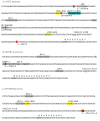Mutation screening of melatonin-related genes in patients with autism spectrum disorders
- PMID: 20377855
- PMCID: PMC3020629
- DOI: 10.1186/1755-8794-3-10
Mutation screening of melatonin-related genes in patients with autism spectrum disorders
Abstract
Background: One consistent finding in autism spectrum disorders (ASD) is a decreased level of the pineal gland hormone melatonin and it has recently been demonstrated that this decrease to a large extent is due to low activity of the acetylserotonin O-methyltransferase (ASMT), the last enzyme in the melatonin synthesis pathway. Moreover, mutations in the ASMT gene have been identified, including a splice site mutation, that were associated with low ASMT activity and melatonin secretion, suggesting that the low ASMT activity observed in autism is, at least partly, due to variation within the ASMT gene.
Methods: In the present study, we have investigated all the genes involved in the melatonin pathway by mutation screening of AA-NAT (arylalkylamine N-acetyltransferase), ASMT, MTNR1A, MTNR1B (melatonin receptor 1A and 1B) and GPR50 (G protein-coupled receptor 50), encoding both synthesis enzymes and the three main receptors of melatonin, in 109 patients with autism spectrum disorders (ASD). A cohort of 188 subjects from the general population was used as a comparison group and was genotyped for the variants identified in the patient sample.
Results: Several rare variants were identified in patients with ASD, including the previously reported splice site mutation in ASMT (IVS5+2T>C). Of the variants affecting protein sequence, only the V124I in the MTNR1B gene was absent in our comparison group. However, mutations were found in upstream regulatory regions in three of the genes investigated, ASMT, MTNR1A, and MTNR1B.
Conclusions: Our report of another ASD patient carrying the splice site mutation IVS5+2T>C, in ASMT further supports an involvement of this gene in autism. Moreover, our results also suggest that other melatonin related genes might be interesting candidates for further investigation in the search for genes involved in autism spectrum disorders and related neurobehavioral phenotypes. However, further studies of the novel variants identified in this study are warranted to shed light on their potential role in the pathophysiology of these disorders.
Figures


Similar articles
-
Mutation screening of ASMT, the last enzyme of the melatonin pathway, in a large sample of patients with intellectual disability.BMC Med Genet. 2011 Jan 20;12:17. doi: 10.1186/1471-2350-12-17. BMC Med Genet. 2011. PMID: 21251267 Free PMC article.
-
Genetic variations of the melatonin pathway in patients with attention-deficit and hyperactivity disorders.J Pineal Res. 2011 Nov;51(4):394-9. doi: 10.1111/j.1600-079X.2011.00902.x. Epub 2011 May 26. J Pineal Res. 2011. PMID: 21615493
-
Identification of pathway-biased and deleterious melatonin receptor mutants in autism spectrum disorders and in the general population.PLoS One. 2010 Jul 15;5(7):e11495. doi: 10.1371/journal.pone.0011495. PLoS One. 2010. PMID: 20657642 Free PMC article.
-
Melatonin receptor genes in vertebrates.Int J Mol Sci. 2013 May 27;14(6):11208-23. doi: 10.3390/ijms140611208. Int J Mol Sci. 2013. PMID: 23712359 Free PMC article. Review.
-
[Association of polymorphic variants of DDC (AADC), AANAT and ASMT genes encoding enzymes for melatonin synthesis with the higher risk of neuropsychiatric disorders].Zh Nevrol Psikhiatr Im S S Korsakova. 2021;121(5):151-157. doi: 10.17116/jnevro2021121041151. Zh Nevrol Psikhiatr Im S S Korsakova. 2021. PMID: 34184492 Review. Russian.
Cited by
-
Melatonin Interventions in Autism Spectrum Disorder: Sleep Regulation, Behavioral Outcomes, and Challenges Across the Lifespan.Mol Neurobiol. 2025 Aug;62(8):9710-9732. doi: 10.1007/s12035-025-04809-5. Epub 2025 Mar 26. Mol Neurobiol. 2025. PMID: 40138120 Review.
-
Sleep in Autism Spectrum Disorders.Curr Sleep Med Rep. 2015 Jun;1(2):131-140. doi: 10.1007/s40675-015-0012-1. Curr Sleep Med Rep. 2015. PMID: 26046012 Free PMC article.
-
Sequencing ASMT identifies rare mutations in Chinese Han patients with autism.PLoS One. 2013;8(1):e53727. doi: 10.1371/journal.pone.0053727. Epub 2013 Jan 17. PLoS One. 2013. PMID: 23349736 Free PMC article.
-
Aberrations in pseudoautosomal regions (PARs) found in infertile men with Y-chromosome microdeletions.J Clin Endocrinol Metab. 2011 Apr;96(4):E674-9. doi: 10.1210/jc.2010-2018. Epub 2011 Jan 20. J Clin Endocrinol Metab. 2011. PMID: 21252244 Free PMC article.
-
[Research advances in candidate genes for autism spectrum disorder].Zhongguo Dang Dai Er Ke Za Zhi. 2016 Mar;18(3):282-7. doi: 10.7499/j.issn.1008-8830.2016.03.018. Zhongguo Dang Dai Er Ke Za Zhi. 2016. PMID: 26975830 Free PMC article. Review. Chinese.
References
-
- Steffenburg S, Gillberg C, Hellgren L, Andersson L, Gillberg IC, Jakobsson G, Bohman M. A twin study of autism in Denmark, Finland, Iceland, Norway and Sweden. Journal of child psychology and psychiatry, and allied disciplines. 1989;30:405–416. doi: 10.1111/j.1469-7610.1989.tb00254.x. - DOI - PubMed
-
- Zhao X, Leotta A, Kustanovich V, Lajonchere C, Geschwind DH, Law K, Law P, Qiu S, Lord C, Sebat J. et al.A unified genetic theory for sporadic and inherited autism. Proceedings of the National Academy of Sciences of the United States of America. 2007;104:12831–12836. doi: 10.1073/pnas.0705803104. - DOI - PMC - PubMed
Publication types
MeSH terms
Substances
LinkOut - more resources
Full Text Sources
Molecular Biology Databases

